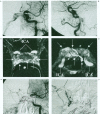Transvenous embolization of dural arteriovenous fistula of the cavernous sinus. Fistulous points and route of catheterization
- PMID: 20587279
- PMCID: PMC3490181
- DOI: 10.1177/15910199040100S113
Transvenous embolization of dural arteriovenous fistula of the cavernous sinus. Fistulous points and route of catheterization
Abstract
We reviewed magnetic resonance (MR) images and digital subtraction angiograms (DSA) from eight patients with dural arteriovenous fistula of the cavernous sinus (DAVFCS) to clarify the fistulous points and to evaluate the venous access routes into the cavernous sinus for transvenous embolization (TVE). Multiplanar reconstruction of the MR images was achieved using three-dimensional fast spoiled gradient-recalled acquisition in the steady state (3-D fast SPGR) after the intravenous administration of gadopentetate dimeglumine (Gd-DTPA). TVE was performed using microcoils via the inferior petrosal sinus (IPS) using the transfemoral approach in five patients, via the facial vein and superior ophthalmic vein (SOV) using the transfemoral approach in 1 patient, and by SOV puncture in two patients. Most fistulas were detected in the posterior portion of the cavernous sinus or in the posterior intercavernous sinus in all of the patients. Fistulas identified as hyperintense dots or lines on contrast-enhanced 3-D fast SPGR images and were replaced with the microcoils. Target embolization of the fistulas was feasible in three patients treated via the SOV and in one patient treated via the IPS. Contrast- enhanced 3-D fast SPGR can help to identify the fistulous points of DAVFCS. Precise identification of fistulous points and selection of the adequate access route are mandatory for efficient TVE of DAVFCS.
Figures






Similar articles
-
Superior Ophthalmic Vein Cannulation for Carotid Cavernous Fistula.2025 Mar 10. In: StatPearls [Internet]. Treasure Island (FL): StatPearls Publishing; 2025 Jan–. 2025 Mar 10. In: StatPearls [Internet]. Treasure Island (FL): StatPearls Publishing; 2025 Jan–. PMID: 30725862 Free Books & Documents.
-
Cavernous sinus dural fistulae treated by transvenous approach through the facial vein: report of seven cases and review of the literature.AJNR Am J Neuroradiol. 2003 Jun-Jul;24(6):1240-6. AJNR Am J Neuroradiol. 2003. PMID: 12812963 Free PMC article.
-
Transfemoral trans-facial vein-superior ophthalmic vein to embolize cavernous sinus dural arteriovenous fistulas.Front Neurol. 2023 Jan 12;13:1078185. doi: 10.3389/fneur.2022.1078185. eCollection 2022. Front Neurol. 2023. PMID: 36712416 Free PMC article. Review.
-
Access-route Visualization Using Ultrasonography and CT Angiography to Predict the Feasibility of Transvenous Embolization via the Facial Vein for Cavernous Sinus Dural Arteriovenous Fistulas.J Neuroendovasc Ther. 2020;14(9):373-380. doi: 10.5797/jnet.oa.2020-0038. Epub 2020 Jul 2. J Neuroendovasc Ther. 2020. PMID: 37501667 Free PMC article.
-
Cavernous sinus dural arteriovenous fistula treated by facial vein direct puncture: Case report and review of the literature.Interv Neuroradiol. 2017 Jun;23(3):301-306. doi: 10.1177/1591019917693413. Epub 2017 Jan 1. Interv Neuroradiol. 2017. PMID: 28604185 Free PMC article. Review.
Cited by
-
Dural arteriovenous fistulas in the cavernous sinus: clinical research and treatment.ISRN Neurol. 2011;2011:453834. doi: 10.5402/2011/453834. Epub 2011 Aug 2. ISRN Neurol. 2011. PMID: 22389817 Free PMC article.
-
Endovascular treatment of the cavernous sinus dural arteriovenous fistula: current status and considerations.Int J Med Sci. 2020 May 1;17(8):1121-1130. doi: 10.7150/ijms.45210. eCollection 2020. Int J Med Sci. 2020. PMID: 32410842 Free PMC article. Review.
-
Shunted pouches of cavernous sinus dural AVFs: evaluation by 3D rotational angiography.Neuroradiology. 2015 Mar;57(3):283-90. doi: 10.1007/s00234-014-1474-4. Epub 2014 Dec 4. Neuroradiology. 2015. PMID: 25471664 Clinical Trial.
-
Focus on the target: Angiographic features of the fistulous point and prognosis of transvenous embolization of cavernous sinus dural arteriovenous fistula.Interv Neuroradiol. 2018 Apr;24(2):197-205. doi: 10.1177/1591019917751894. Epub 2018 Jan 19. Interv Neuroradiol. 2018. PMID: 29350092 Free PMC article.
-
Evaluation for shunted pouches of cavernous sinus dural arteriovenous fistula and the treatment outcome of transvenous embolization.Interv Neuroradiol. 2018 Apr;24(2):189-196. doi: 10.1177/1591019917743064. Epub 2017 Nov 29. Interv Neuroradiol. 2018. PMID: 29183173 Free PMC article.
References
-
- Yamashita K, Taki W, et al. Transvenous embolization of dural caroticocavernous fistulae: technical condiderations. Neuroradiology. 1993;35:475–479. - PubMed
-
- Benndorf G, Bender A, et al. Transvenous occlusion of dural cavernous sinus fistulas through the thrombosed inferior petrosal sinus: report of four cases and review of the literature. Surg Neurol. 2000;54:42–54. - PubMed
LinkOut - more resources
Full Text Sources

